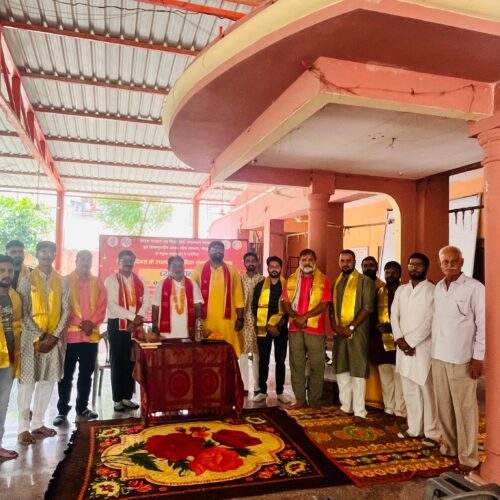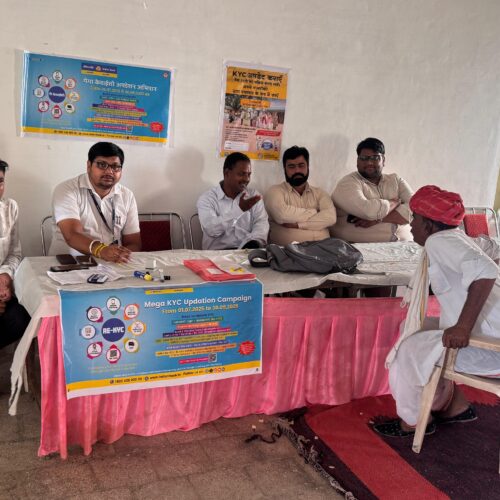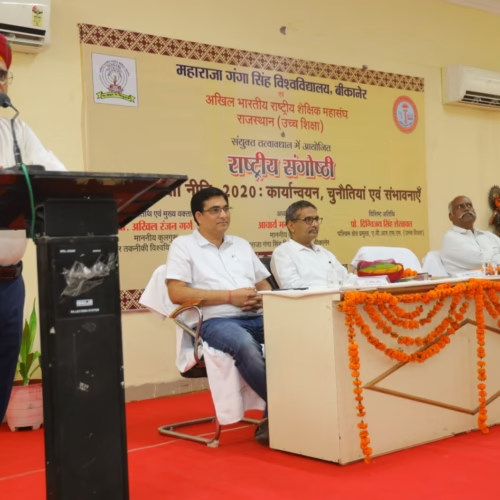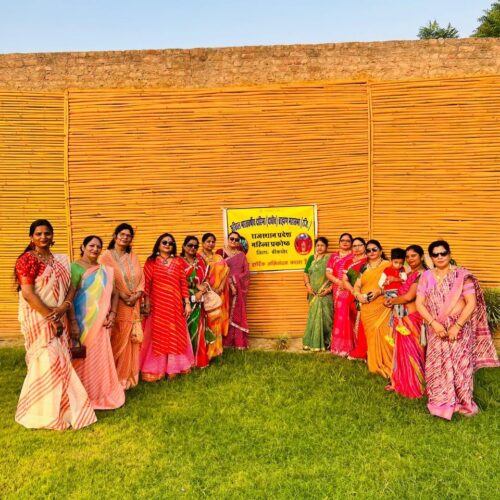BY DEFENCE JOURNALIST SAHIL
Bikaner’s Raksha Bandhan 2025: Operation Sindoor-Inspired Swadeshi Rakhis Spark a Wave of Patriotism, Creativity, and Self-Reliance
From resin art masterpieces to eco-friendly wool threads and gold-kundan traditions, Bikaner’s markets embraced the spirit of Operation Sindoor, turning a festival of siblings into a celebration of Indian pride and women’s empowerment.
Bikaner — Where Tradition Meets National Pride
This Raksha Bandhan, the historic desert city of Bikaner was not merely a witness to the age-old celebration of sibling bonds — it became the stage for a rare fusion of tradition, innovation, and patriotism. The bustling markets, especially Kotgate and Rani Bazaar, turned into showcases of Swadeshi craftsmanship, with the spotlight firmly on the “Operation Sindoor”-themed rakhis that symbolised the bravery and sacrifice of Indian soldiers.
The initiative drew from the recent national sentiment surrounding Operation Sindoor — a tribute to the courage of India’s armed forces. These rakhis, adorned with tricolour motifs, army insignia, and ‘Jai Hind’ slogans, became more than just threads — they became tokens of gratitude from sisters to the nation’s protectors.
A Conscious Move Away from Chinese Imports
Shopkeepers across Bikaner noted an unmistakable trend this year — buyers were deliberately steering away from Chinese-made rakhis and gravitating toward locally crafted, Indian-themed designs. For many, the choice was not just about quality or style; it was a statement. Families openly expressed their desire to support the Indian economy, empower local artisans, and reject mass-produced imports.
Resin Art — The Star of the Market
Among the standout creations were resin art rakhis — intricately designed, glossy keepsakes crafted by local women, students, and homemakers. Some featured customised elements such as the brother’s name, photographs, or miniature representations of national symbols. For buyers, these weren’t disposable ornaments; they were pieces to be treasured long after the festival.
Alongside, wool-based eco-friendly rakhis appealed to buyers mindful of environmental impact. These lightweight, handwoven pieces, often adorned with small beads or embroidered motifs, offered both beauty and sustainability.
The Golden Heritage — Traditional Sonaari Craft
Adding regal charm to the festival, Bikaner’s traditional jewellers unveiled gold-chain rakhis studded with kundan work, rudraksha beads, and fine engraving. These were not just festive accessories but heirloom keepsakes — designed to last decades as a cherished memory of sibling love. Many sisters specially ordered such rakhis to present to their brothers as both a token of affection and a mark of prosperity.
Women and Students as Catalysts of Change
A defining feature of this year’s Raksha Bandhan was the visible leadership of women and young girls in shaping the market. Across Bikaner’s residential colonies, schools, and self-help groups, hundreds of women turned their homes into miniature workshops. Using wool, paper, resin, wood, and embroidery threads, they created hundreds of rakhi varieties, each carrying a unique design language.
The economic impact was tangible. Many women reported earning substantial income in the weeks leading up to the festival, boosting household finances and reinforcing the link between festive culture and livelihood creation.
From Decorative to Thoughtful Gifting
Another notable shift was in buyer psychology. Young women and girls in the markets were seen choosing rakhis not for their size or glitter, but for their meaning and origin. Many openly stated they preferred designs that were locally made, environmentally friendly, and connected to a livelihood story. This “conscious consumer” mindset meant that every rakhi purchase became a small act of social support.
A Festival Turning Into a Movement
This transformation of Raksha Bandhan in Bikaner underlines a wider cultural shift in India — where festivals are not just rituals but platforms for patriotism, social change, and economic empowerment. Operation Sindoor’s thematic influence infused the celebration with emotional depth, ensuring that every rakhi tied this year carried not just love for a brother, but also pride for the nation.
ऑपरेशन सिंदूर और स्वदेशी राखियों से सजा बीकानेर का बाजार — देशभक्ति, नवाचार और आत्मनिर्भरता की अनोखी मिसाल
रेज़िन आर्ट, ऊन की पारंपरिक राखियां और सुनारी शिल्प — बीकानेर की गलियों में रक्षाबंधन का त्योहार इस बार भाई-बहन के प्रेम के साथ-साथ देश के जवानों को समर्पित रहा।
बीकानेर — परंपरा और देशभक्ति का संगम
रेगिस्तानी शहर बीकानेर इस बार रक्षाबंधन के अवसर पर केवल भाई-बहन के अटूट रिश्ते का ही गवाह नहीं बना, बल्कि यहां की गलियां और बाजार देशभक्ति और स्वदेशी भावना से भी सराबोर रहीं। कोटगेट और रानी बाजार की रंगीन दुकानों में इस बार ऑपरेशन सिंदूर थीम पर बनी विशेष राखियों की धूम रही।
इन राखियों में तिरंगे के रंग, सैनिक प्रतीक, और “जय हिंद” संदेश उकेरे गए थे। ये केवल धागे नहीं थे, बल्कि भारतीय सैनिकों के पराक्रम और बलिदान को नमन करने वाले प्रेम के प्रतीक थे।
चाइनीज राखियों को मिला सख्त जवाब
दुकानदारों के अनुसार, इस बार ग्राहकों ने साफ़ तौर पर चाइनीज राखियों से दूरी बनाई और स्थानीय कारीगरों द्वारा बनाई गई स्वदेशी राखियों को प्राथमिकता दी। यह चुनाव सिर्फ़ डिज़ाइन या गुणवत्ता के कारण नहीं था, बल्कि एक देशभक्ति और आर्थिक स्वावलंबन का बयान भी था।
रेज़िन आर्ट बनी बाजार की जान
इस बार सबसे ज़्यादा ध्यान खींचा रेज़िन आर्ट राखियों ने। इन्हें स्थानीय युवतियों, गृहिणियों और छात्राओं ने अपने हाथों से तैयार किया था। इनमें भाई का नाम, तस्वीर या देशभक्ति के प्रतीक बड़ी बारीकी से सजाए गए थे। खरीदार इन राखियों को त्योहार के बाद भी एक यादगार के रूप में सहेजकर रखने की योजना बना रहे थे।
इसी के साथ, ऊन से बनी इको-फ्रेंडली राखियां भी खूब बिकीं — हल्की, सुंदर और पर्यावरण के अनुकूल।
सुनार शिल्प की शान
बीकानेर के पारंपरिक सुनार इस बार भी पीछे नहीं रहे। सोने की पतली चेन, कुंदन, रुद्राक्ष और महीन नक्काशी से सजी राखियां बाजार में अलग ही आकर्षण का केंद्र रहीं। ये केवल त्योहार की सजावट नहीं, बल्कि आने वाले वर्षों तक संजोकर रखने लायक धरोहर थीं।
महिलाओं और छात्राओं की भूमिका
बीकानेर की कॉलोनियों, स्कूलों और स्व-सहायता समूहों से जुड़ी महिलाओं ने घर-घर में राखियां तैयार कीं। ऊन, कागज, लकड़ी, रेज़िन और कढ़ाई से बनी इन राखियों ने बाजार में रचनात्मकता की नई मिसाल पेश की।
इन प्रयासों का आर्थिक असर भी स्पष्ट दिखा — कई महिलाओं ने त्योहार से पहले ही अच्छी आमदनी अर्जित की, जिससे उनके परिवार की आय में सीधा योगदान हुआ।
सजावट से सोच तक का सफर
बाजार में युवतियों को इस बार भारी-भरकम और चमकीली राखियों की बजाय उन राखियों को चुनते देखा गया जो स्थानीय रूप से बनी हों, पर्यावरण के अनुकूल हों और किसी के रोजगार से जुड़ी हों। यह बदलाव इस ओर संकेत करता है कि अब त्योहार केवल दिखावे का माध्यम नहीं, बल्कि सामाजिक और आर्थिक परिवर्तन का जरिया भी बन रहे हैं।
त्योहार से आगे बढ़ता संदेश
बीकानेर में इस बार का रक्षाबंधन एक संदेश लेकर आया — त्योहार सिर्फ़ परंपरा निभाने के लिए नहीं, बल्कि देशभक्ति, स्वदेशी और आत्मनिर्भरता की मशाल जलाने के लिए भी होते हैं। ऑपरेशन सिंदूर की प्रेरणा से सजी ये राखियां आने वाले वर्षों में भी भाई-बहन के प्रेम के साथ भारत के प्रति गर्व का प्रतीक बनी रहेंगी।














Add Comment